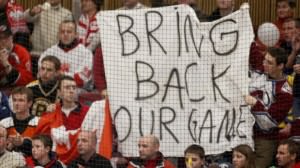Why the NHL is in Lockout Mode
Controlling the Cap Situation would end the Lock-out
By Tejas Shah, Online Editor
For the second time in eight years, hockey fans across North America are forced to find other sources of entertainment as NHL continues to cancel regular season games. What caused this lockout in the first place and what are the effects of these disagreements over money? For one things, the KHL and minor league hockey are beginning to look like admirable alternatives to the NHL because owners and players are less likely to fight over the distribution of money.
Firstly, the causes of the lockout: One factor is profit distribution. Profit distribution and uneven revenues are natural and need to be tidied up by the management. However, small market teams will naturally have lower revenues and profits and need to expand their marketing and advertising in order to attract attention. The lockout is not helping.
Speaking to reporters after talks finished up for the day between the NHL and the NHLPA, Deputy Commissioner Bill Daly estimated that the league has lost $100 million in revenues from the canceled preseason and a further $260 million from the loss of the first two weeks of the season. The league might pull the plug on up to a month’s worth of games by the end of the week if there is no further progress.
The lockout also stems from disagreements about player salaries. Teams are now balking under the weight of heavily front-ended contracts that last sometimes over 10 years. In consequence, owners now want to cut players’ salaries. Having their salaries cut will make players more hesitant to play in the NHL because they will fear that their contracts will not be honored by management.[pullquote]The gap is closing, and with higher monetary incentives and job security abroad, the luster and glamour of playing in the NHL will diminish.[/pullquote]
European leagues like the KHL will benefit from players’ dissatisfaction in the States because their league offers more guarantees and more money while players get the luxury of paying fewer taxes. In a press statement released by KHL Hockey Operations Vice-President Vladimir Shalaev, the current salary cap “will be 1.1 billion rubles, or approximately US$36 million”. The current salary cap in the NHL borders on US $60 million. In other words, the gap is closing, and with higher monetary incentives and job security abroad, the luster and glamour of playing in the NHL will diminish.
This situation impacts hockey fans in communities in North America and cripples revenues of small market teams because without the presence of star players and a winning team, it becomes more difficult to draw crowds and fuel revenue growth.
The New Jersey Devil’s Ilya Kovalchuk debacle, which resulted in a loss of a draft pick and playing short-handed for a quarter of the season, created a frenzy of throwing large amounts of money at players for a long period of time. To prevent this kind of situation from happening again, a hard salary cap should be in place for 5 years, forcing teams to redistribute their high paid players to other teams. If the cap doesn’t rise, teams will be forced to start offering lower term contracts which will consequently offer less money. Secondly, the $15 million ceiling needs to be reduced for future contracts in order to prevent owners from front loading contracts. This will reduce the term of the contracts and consequently the salaries, while guaranteeing the contract of the player.
As each day of the lockout goes by, frustration grows and people like sponsors wonder if it’s worth it. However, by controlling the cap situation and not cutting player salaries, a much more manageable NHL can be created.































Share the post "Why the NHL is in Lockout Mode"